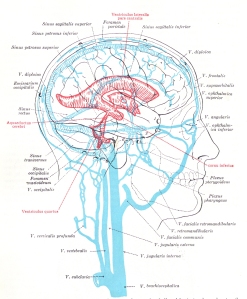There are obviously problems in using ultrasound to determine venous stenosis. For one not everyone is coming up with the same results. The other problem, when it comes to stenosis, is that veins and arteries are dynamic, not static. They change according to circumstances and loads. Technically, it’s called compliance.
During inversion for example, there is a great deal of compliance in the vertebral veins in the spinal canal and the dural sinuses of the brain which have no valves to prevent or check reverse flow, such as those found in the jugular and most other veins. In the extremities, veins expand easily, such as seen in varicosities in the legs. Similarly, if you raise your hand overhead the veins on the surface of the hands with shrink in size, but if you let them hang by your sides they will expand as they fill with blood.
Stenosis is also controversial when it comes to arteries. Heart attacks were once blamed on stenosis of the coronary arteries and many patients elected to have angioplasty and stents put in to improve flow. Unfortunately, it has done nothing to reduce the death rate from heart attacks. Many cases resulted in re-stenosis. Some even caused stroke and heart attacks due to thrombus formation on the old metal stents. If anything, stenosis causes angina, not heart attacks. Heart attacks are typically caused by thrombus that break loose from areas that have been shown to have nothing to do with the stenosis. It has been shown that patients with more than seventy percent stenosis often had no problems.
In adddition, the assesment of stenosis is made while the patient is lying down and anesthetized, in this condition there aren’t any demands on the circulatory system. An artery would have to be severely calcified not to comply at all. In other words, stenosis is a relative term and like angioplasty and stents in coronary arteries venous angioplasty and stents will most likely be subject to the same problems, including re-stenosis.
Nonetheless, the so called liberation procedure appears to be working quite well, and that’s good news for all the MS patients dealing with serious disabilities. But it may work for different reasons other than improving venous stenosis. It may work by siphoning blood from the clogged drainage system of the brain similar to siphoning gas from the tank of a car. Opening the jugular and thoracic veins creates a void, which probably draws blood out of the brain similar to the effect of upright posture on blood flow in the brain. With this in mind, there may be other options for improving venous drainage issues based on the same premise but due to blockage in the vertebral veins not the jugulars. I will discuss it in future posts.
In the mean time, the role of venous drainage issues in causing MS is just the tip of the iceberg. Aging baby boomers, Alzheimer’s and Parkinson’s are the iceberg. MS patients should join forces with AD and PD patients as their conditions may share similar root causes.


gonna send this to my mom
Wow! Dr Flanagan is writing on what I live. I can rest in peace, but im not dead yet!